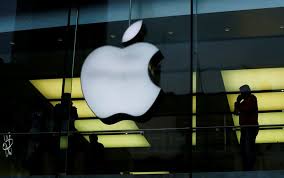Apple Will Probably Report Bad iPhone X News Tuesday. Here’s How Tim Cook May Try to Fix the Problem

Apple earnings this week will confirm what most investors have finally accepted: The iPhone X didn’t live up to the hype. The results should also provide clues on the company’s next strategy for its most-important product.
Chief Executive Officer Tim Cook and other Apple executives have a “major prove-me” period ahead, beginning with a new sales forecast and a conference call with analysts on Tuesday, GBH Insights analyst Daniel Ives said. He and other analysts cut their iPhone sales estimates, and Apple stock is down almost 8% in the past two weeks.
Concerns were fanned by suppliers reporting weak demand for high-end handsets, another sign the smartphone boom that made Apple the most-valuable company is ebbing. It’s also under pressure in China, where some consumers are shunning pricey iPhones and local rivals like Oppo and Vivo are grabbing market share.
On Tuesday, Apple (aapl) is expected to report fiscal second-quarter iPhone unit sales grew just over 2% from a year earlier. For the fiscal third quarter, unit sales will be down 5% year-over-year, according to average analyst forecasts compiled by Bloomberg.
Expectations were higher when Apple launched new phones late last year. However, the iPhone 8 and 8 Plus looked similar to the iPhone 6 and 6 Plus models from about three years earlier. The iPhone X had a bright, edge-to-edge display and 3-D facial recognition, but the $ 999 starting price was too much for some consumers.
That left a hole in the market for a breakthrough iPhone close to the previous price — and Apple is already working on filling this demand. The company is preparing a new lower-cost iPhone that looks similar to the iPhone X and has some of its most-appealing features, Bloomberg News reported earlier this year.
“That lower-priced iPhone X, essentially, should be a successful product. That launch itself could move iPhone sales up 5% a year,” said Gene Munster, co-founder of Loup Ventures and a longtime Apple analyst. Still, he warned that the days of 15% annual iPhone growth are over.
When the X launched last year, Apple paid handsomely for the new Face ID system, stainless steel casing and sharper, more efficient OLED screen technology. The iPhone X’s parts cost $ 115 more than the iPhone 8’s, according to a November analysis. That made it difficult to price the product much below $ 999, without slicing Apple’s legendary profitability.
The new, lower-cost iPhone will use an LCD display that’s about half the cost of the OLED screen in the iPhone X. It’s also likely to use an aluminum casing versus stainless steel. That could bring the price close to $ 700, a level that’s proven successful for many years.
In addition, Apple will launch a giant iPhone with a 6.5-inch screen and an update to the current iPhone X size, people familiar with the matter told Bloomberg News earlier this year.
While results on Tuesday will likely show slower Apple growth, this broader iPhone strategy could revive sales when the new devices come out toward the end of 2018.
For most companies, one product facing growth headwinds wouldn’t be a concern. For Apple, the iPhone generates about two-thirds of sales, and the other third comes mostly from products and services best used with an iPhone. Here are some of the key numbers to watch on Tuesday:
Analysts are looking for revenue of $ 61 billion in the fiscal second quarter, or 15% year-over-year growth, according to data compiled by Bloomberg. Earlier this year, Apple forecast sales between $ 60 billion and $ 62 billion for the period. Fiscal second-quarter iPhone unit sales are expected to be 51.9 million, up from 50.8 million a year earlier, according to average analyst forecasts compiled by Bloomberg. For the fiscal third quarter, analysts see 39 million iPhones sold, on average, down from 41 million in the same period of 2017. The average selling price for iPhones will be $ 740 in the fiscal second quarter and $ 691 in the third, according to average analyst projections. Fiscal second quarter services revenue will hit around the $ 8.5 billion level reported in the holiday quarter. Munster sees 18% to 20% growth. Analysts are also looking for growth in Apple’s Other Products unit, which includes the Apple Watch, AirPods and HomePod.
Bernstein analyst Toni Sacconaghi said weakness in the current iPhone lineup was caused by a structural slowdown in the growth of new customers and the high pricing of the X model. A saturated smartphone market means Apple can’t do much about the first problem, but its pricing strategy can vary depending on the specific iPhones being offered.
“The rumored lineup could quickly change, and pricing remains a wild card – Apple appears to have somewhat mis-estimated price elasticity this time around, but what might they change going forward?” Sacconaghi wrote in a recent note to investors.
